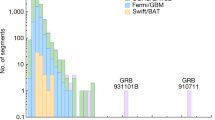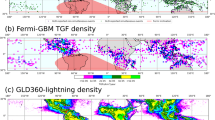Abstract
DETECTION of gamma-ray bursts of cosmic origin by detectors onboard Vela, OGO, IMP-6 and OSO-7 satellites1–3 was one of the major surprises of observational astronomy recently. The bursts were observed over the energy range 7 keV to 1.5 MeV and were found to have time durations ranging from less than a second to about 80 s with integrated flux density between a few times 10−6 and 3 × 10−4 erg cm−2 for different events. From the 20 events that have been detected so far (from data accumulated over 5 yr) it seems that these events are distributed almost isotropically on the celestial sphere and occur at frequencies of about four to five each year, at the level of sensitivity of Vela satellites. In view of the absence of definitive positive associations with well known transient phenomena1,4 such as supernovae, galactic radio noise spikes, rapid atmospheric fluorescence increases, Cygnus X-3 radio flares or even with gravitational radiation events, continuous patrol for detecting these events through as many independent techniques as possible is very important to understand the nature of their origin.
This is a preview of subscription content, access via your institution
Access options
Subscribe to this journal
Receive 51 print issues and online access
$199.00 per year
only $3.90 per issue
Buy this article
- Purchase on Springer Link
- Instant access to full article PDF
Prices may be subject to local taxes which are calculated during checkout
Similar content being viewed by others
References
Klebesadel, R. A., Strong, I. B., and Olson, R. A., Astrophys. J. Lett., 182, L85–88 (1973).
Cline, T. L., Desai, U. D., Klabesadel, R. W., and Strong, I. B., Astrophys. J. Lett., 185, L1–6 (1973).
L'Heuneux, J., Astrophys. J. Lett., 187, L53–56 (1974).
Cline, T. L., and Desai, U. D., Proc. 13th int. Cosmic Ray Conf., 1, Paper 136, 80 (Hobart, 1973).
Ananthakrishnan, S., and Ramanathan, K. R., Nature, 223, 488 (1969).
Sharma, D. P., Jain, A. K., Chakravarty, S. C., Kasturirangan, K., Ramanathan, K. R., and Rao, U. R., Astrophys. Space Sci., 17, 409–25 (1972).
Strong, I. B., Klabesadel, R. W., and Olson, R. A., Astrophys. J. Lett., 188, L1 (1974).
Wheaton, W. A., Ulmer, M. P., Baity, W. A., Datlowe, D. W., Elcan, M. L., Peterson, L. E., Klabesadel, R. W., Strong, I. B., Cline, T. L., and Desai, U. D., Astrophys. J. Lett., 185, L57–62 (1973).
Swider, W., jun., Rev. Geophys., 7 Z, 573 (1969).
Author information
Authors and Affiliations
Rights and permissions
About this article
Cite this article
KASTURIRANGAN, K., RAO, U., SHARMA, D. et al. An attempt to detect the effects of cosmic gamma-ray bursts in the lower ionosphere. Nature 252, 113–114 (1974). https://doi.org/10.1038/252113a0
Received:
Issue Date:
DOI: https://doi.org/10.1038/252113a0
This article is cited by
-
Ionization effects from cosmic sources of x-rays in the lower atmosphere
Proceedings / Indian Academy of Sciences (1978)
-
The x-ray astronomy experiment
Proceedings of the Indian Academy of Sciences Section C: Engineering Sciences (1978)
-
Ionospheric techniques for the detection of transient X- and ?-ray bursts
Astrophysics and Space Science (1976)
Comments
By submitting a comment you agree to abide by our Terms and Community Guidelines. If you find something abusive or that does not comply with our terms or guidelines please flag it as inappropriate.



